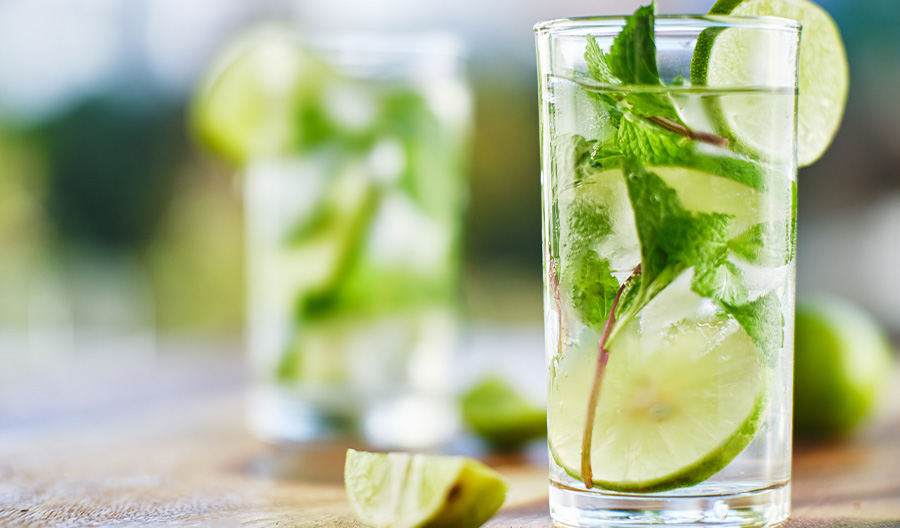For a certain type of bar these days, there’s an arms race to source the most niche and distinct spirits possible. Bartenders hunt for vintage bottles, stock small-batch spirits that express terroir, and spend countless prep hours infusing and centrifuging spirits to give them one-of-a-kind character.
But modern cocktail culture has also given us a counterweight to this obsession with singularity and rarity. “I affectionately label it ‘trash craft,’” says a bartender in Omaha, Nebraska.
For purveyors of this cheeky style of drink making, developing a cocktail means tapping into bottles that are profoundly uncool, mass-produced, and often cloyingly sweet—the types of spirits that dredge up less-than-pleasant drinking memories (I can still smell you, coconut rum, from spring break 2004).
We recently spoke with eight bar pros about why they love mixing with maligned spirits—from peach schnapps to melon and mint liqueurs—and how they turn them into balanced, crowd-pleasing cocktails.
Herbal Liqueur
“I’ve pretty consistently managed to get people to like at least one drink that has this digestif in it,” says the Omaha bartender, who fell in love with the syrupy, herbal, licorice-heavy amaro as a young barback. “Bringing people around to it is one of my simple joys in life.”
To convert guests, many of whom first experienced the liqueur in an ill-advised, energy drink-fueled Bomb, he created the equal-parts Red Eye. It includes ¾ ounce each herbal liqueur, coffee-infused bourbon, dry curaçao, and coconut cream—all shaken and double-strained into a coupe with an orange peel garnish. Instead of listing the herbal liqueur in the menu description, he went with the more generic “amaro,” and the Red Eye shot up on the bar’s best-seller list.
“I was accused of trying to hide the liqueur,” he says . But really, he insists, he did it all in service of the spirit, using the Red Eye’s other ingredients to tone down the liqueur's polarizing licorice finish and enhance its cocoa, caramel, and baking spice notes. “The drink comes out balanced and reminiscent of those chocolate oranges that pop up in stores in the wintertime,” he says.
Melon Liqueur
Melon-flavored liqueur had its heyday in the ‘80s, lighting up sours with its day-glo green hue, but in the last few years, bartenders have again started to reserve back bar space for the Japanese liqueur. “We reach for the bottle frequently as a modifier at our Nashville bar, share's the owner. “It’s easily one of the best-executed melon spirits on the market, and plays nicely with bright acidic sours, fern bar-era cocktails, and even adds a nice balance to the savory, leathery notes in mezcal and sotol.”
The bar currently serves a melon liqueur-spiked Ramos Gin Fizz riff, the Ramos Melon Fizz, made with toasted rice-washed gin, lime stock, cream, an egg white, melon liqueur, soda, and a dusting of matcha. “It adds a floral, summery backdrop to this lightly green take on the classic,” she says.

Peach Schnapps
Despite its reputation for crippling amateur drinkers and anchoring low-brow drinks like the Fuzzy Navel and Sex on the Beach, on Baltimore mixonogist can’t resist the allure of peach schnapps. “Peach schnapps lends sweetness with subtle fruit flavor to cocktails. A little will always go a long way,” she says. “It’s also great to add to cocktails that need just a touch of stone fruit flavor or a touch of summer in the colder months.”
For drink making, she keeps it simple with a Tequila Sunrise riff. Fill a Collins glass with crushed ice and add ¾ ounce each mezcal and blanco tequila plus ½ ounce peach schnapps. Top with orange or pineapple juice, then drop ½ ounce of grenadine along the side of the glass to achieve a bottom red layer.
Side note: She says “iced tea and peach schnapps is simply amazing.”
Coconut Rum
A Chicago barkeep remembers mixing coconut-flavored rum and water as a freshly minted 21-year-old drinker. When she started developing vegan, coconut-based milk punches she cracked open a bottle of the nostalgic rum for her base. “It is easy and low-ABV,” she says. “People sleep on it, but I love it!”
Since that first fateful combination, she has made a series of increasingly wild, weird, and wonderful coconut rum milk punches. Her Squirtle includes coconut rum, vodka, lemon and lime juices, coconut milk, and blue raspberry snow cone syrup.
Creme de Menthe
As a girl, one woman would descend the stairs to her grandparents’ basement, where her elders had set up a mid-century wooden bar. As she sorted through the bottles for fun, one always stood out: creme de menthe. “The bright green liquid looked like a magical potion to me,” she says.
Now the beverage director of a restaurant in Queens, New York, she recently created the tropical, rum-based Mejiro cocktail, whose bright green color comes compliments of retro creme de menthe. “The Mejiro came out of something I call the forgotten bottle challenge. It’s a game where I go to the liquor room and pick a random single bottle and create a drink with it,” she says. “Is it just me or does every bar in America have a dusty bottle of creme de menthe somewhere?”
The complex specs include 1 ounce Caribbean white rum, ½ ounce Jamaican white rum, ¾ ounce lime juice, ½ ounce each almond orgeat and Don’s Mix (combine two parts white grapefruit juice with one part cinnamon syrup), and ¼ ounce each of banana liqueur and green creme de menthe. Fresh nutmeg and mint garnishes tie everything together.

